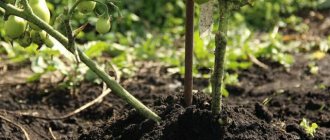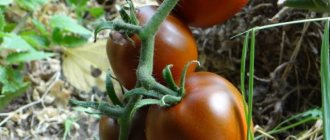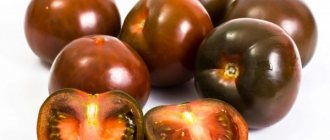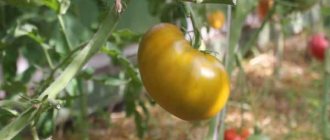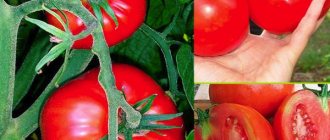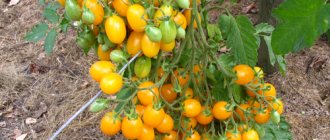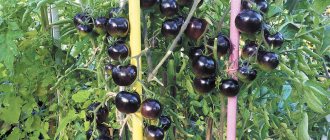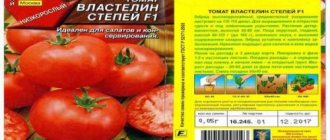Among the variety of tomatoes with unusual berry colors, it is the black ones that are of particular interest to gardeners. The first tomatoes with such an exotic shade were bred in the mid-20th century by Chilean breeders by crossing cultivated and wild varieties.
Having developed black-fruited tomatoes, breeders did not stop working on them. They began to experiment with shape, which led to the creation of the Black Pear tomato. This variety has excellent taste and an interesting appearance and shape. Read on to learn how to grow it on your own property.
General description of black pear
The Black Pear variety has been present in horticultural markets for a long time and has already gained popularity among gardeners. This crop has not yet been included in the state register.
Seeds of the variety are produced by many Russian companies, “Gavrish”, “Russian Garden”.
Distinctive features
The main feature of the Black Pear tomato is the exotic color of the fruit. They are dark brown, almost brown. Reddish, yellow and dark green spots may be present.
The shape of the tomatoes is also unusual - pear-shaped, with pronounced ribbing. Thanks to this, they resemble small bright pears.
The dark color of the fruit is due to the anthocyanin content in them. This substance has a pronounced antitoxic effect. Therefore, the inclusion of Black Pear in the diet has a beneficial effect on the condition of blood vessels, heart, hair and skin. The variety is also rich in carotene and vitamins.
Black pear has a pleasant sweet taste. The more sun the tomatoes receive, the more pronounced their sweetness. If you grow this variety in the shade, the tomatoes will turn out tasteless.
Important . A negative feature of the variety is its capriciousness regarding the composition of the soil. Such tomatoes especially do not like soils with high acidity. This applies to all black tomatoes.
Main characteristics
The characteristics of the Black Pear are attractive to experienced gardeners. This variety is grown both for oneself and for sale.
Description of the Black Pear tomato:
| Parameter | Indicators |
| Bush type | Indeterminate variety. The tomato reaches a height of 1.9 m. The stems are powerful, with an average amount of foliage. Stepchildren are formed in large numbers. The leaves are dark green, similar to potato leaves. Size is medium. The inflorescences are simple. The first appears in the axil of the 9th or 10th leaf, the next - every 1-2 leaves. |
| Growing method | Heat-loving variety. In northern regions and areas with a temperate climate, planting is possible only in greenhouses. In the south of our country, tomatoes are grown in unprotected soil. |
| Productivity | Average. With proper agricultural technology, 5 kg of fruits are obtained from one bush. For 1 sq. m place no more than 3 plants. |
| Fruit | Average. The weight of one berry reaches 50-80 g. There are specimens weighing 100 g. The outside of the tomatoes is dark brown with brown spots. Sometimes pink, olive and yellowish areas are present. The inside of the tomatoes is brown, the seed chambers are darker. There may be small green spots near the base. The fruits are very sweet, with virtually no sourness. The shape is pear-shaped, with moderate ribbing. Inside there are 2 seed chambers with a small content of seeds. The variety is rich in vitamins and nutrients. |
| Transportability | Average. The skin is thin but durable. Transportation over long distances is possible. These berries can be stored for up to 3 weeks. |
| Ripening time | Mid-season tomatoes. From the moment the seeds are sown until the fruits ripen, 150 days pass. Fruiting continues until the first frost. |
| Disease resistance | Resistant to the main tomato diseases: fusarium, late blight, various types of rot. |
Tomato Kumato: characteristics and description of the variety, photos of fruits
Kumato tomatoes are becoming increasingly popular in Russia. Hybrid tomatoes are still not in the State Register of the Russian Federation, but this fact does not prevent them from winning the love of many Russian gardeners. Kumato variety tomatoes have recently become increasingly common in Russia. The hybrid variety of tomatoes appeared about 40 years ago and was not included in the State Register of the Russian Federation. Despite such nuances, growing Kumato tomatoes is successful and guarantees a rich harvest.
Description and characteristics of the variety
Kumato is an indeterminate tomato variety that is mid-season. Cultivation is recommended in greenhouses, as tomatoes are particularly susceptible to weather conditions
To obtain a high-quality harvest, it is extremely important to create optimal conditions and protect the vegetable crop from frost.
The Kumato tomato bush usually grows to 1.8-2 meters. It is impossible to do without pinching and tying to a reliable support. The best results for growing tomatoes are guaranteed when 2-3 stems are formed, and the grown tomatoes should please you with their impeccable structure and pleasant taste characteristics.
Kumato tomato bushes are distinguished by the fact that the fruits are always collected in clusters of 6-8 pieces.
The main differences between ripened tomatoes:
- rounded, smooth shape;
- approximately the same weight of ripened tomatoes;
- red-brown color when ripe;
- thick skin;
- juicy and sweet pulp;
- weight is 100-150 grams.
Such Kumato variety tomatoes have an attractive and very original appearance.
Advantages and disadvantages of the variety
Kumato variety tomatoes have the following important advantages:
- the optimal yield indicator, because from one bush you can collect up to 8 kilograms of fruit, from a square meter - up to 15 kilograms;
- optimal taste characteristics and the possibility of successfully using the crop for culinary purposes;
- increased resistance to transportation even over long distances;
- resistance to heat, but the variety in question shows particular weakness in the face of adverse weather conditions;
- increased resistance to diseases and parasites;
- no GMOs.
The above advantages contribute to the active growth in the popularity of Kumato variety tomatoes. It should be noted that the only obvious drawback is the color of ripe tomatoes, since not everyone likes it.
Gardeners should be prepared for the fact that the seeds germinate quickly, but subsequently the growth of tomato bushes and the ripening of fruits slows down. In addition, the same correct shape is not always common, so sometimes deviations from the correct shape lead to some deterioration in the appearance of the resulting tomatoes.
Rules for growing the variety
Kumato tomatoes are grown using standard agricultural techniques. It is advisable to plant the seeds in early March, and they are pre-treated with potassium permanganate and washed with running water. This treatment of seed material increases the chances of successfully growing tomatoes. When planting seeds, you can use a special solution for stimulation.
It is advisable to plant seed material in soil that is disinfected and steamed from microorganisms. Planting is carried out to a depth of 2 centimeters. The result is the basis for successful tomato growing.
About 2 weeks before planting, the plants are hardened off. In mid-May, tomatoes are transplanted into a greenhouse, and in late spring or early summer - into open ground. Severe cold should be guaranteed to pass. It is best to plant tomatoes in holes at a distance of about 50 centimeters from each other so that they can grow successfully and delight you with an impeccable harvest.
What are the further steps for caring for Kumato tomatoes?
- Regular watering with warm water is mandatory. In this case, the soil should not be too wet, as otherwise the risk of rotting tomatoes increases. It is advisable to water by drip every 5-7 days.
- Fertilizers and mulching with organic matter must be carried out by gardeners. The main task is to fertilize tomatoes for their successful cultivation.
- Prevention of diseases and pests becomes mandatory. Gardeners need to understand how best to carry out preventative measures to achieve a perfect harvest.
- Pinching and tying up tomato bushes is necessary for the full formation of tomato stems and obtaining a decent harvest.
- Long-term fruiting involves a prolonged harvest of fruits.
Such comprehensive care for Kumato variety tomatoes guarantees a decent harvest.
How to grow quality seedlings
The Black Pear tomato is grown in our country only by seedlings. Seeds are sown two months before planting tomatoes in a permanent place.
Since only in the south of our country is it possible to grow tomatoes in open ground, seeds for seedlings in all regions are sown in the second half of March. Before sowing, it is recommended to familiarize yourself with the lunar calendar.
Working with seeds
Changing Black pears need to be sorted out, removing all damaged and darkened specimens. After this, the planting material is soaked in a saline solution. To prepare it, stir 1 tsp in a glass of water. salt.
Most manufacturers treat seeds in the factory with a disinfectant solution. This should be indicated on the packaging. The pickled planting material is painted orange or light green.
If the seeds are not pickled, this is done at home. To do this, they are treated with a solution of potassium permanganate (1 g per 100 ml), soda solution (100 ml of water and 0.5 tsp of soda), aloe (juice and water in equal proportions).
After this, seed germination is stimulated. You can do this in several ways:
- aloe juice;
- "Epinom";
- water with honey.
Selection of soil and containers
Light and nutritious soil is suitable for tomatoes.
Suitable formulations are sold in gardening stores. Prepare soil mixtures for growing tomatoes yourself. To prepare the soil, take soil from the garden or greenhouse and add peat and humus in equal proportions. To make the composition lighter, it is mixed with sand, crushed coconut substrate or sawdust.
The finished soil is watered with a solution of potassium permanganate or calcined in the oven. They do the same with purchased land.
When growing seedlings in the most popular way, the seeds are sown in one spacious shallow container with a volume of at least 300 ml. Use special boxes and trays or improvised means.
Plastic and peat pots are sold in stores. Gardeners often use disposable cups or cut-off bottles. In homemade containers, drainage holes must be made.
The containers also need to be treated. The easiest way is to soak them for half an hour in a solution of potassium permanganate.
Note! Black pear seeds have a high price. Therefore, it is advisable to plant them in peat tablets.
Sowing seeds in the usual way and in peat tablets
When sowing seeds in the usual way, the soil is watered abundantly in advance. Then grooves 1 cm deep are made in it. A distance of 2-3 cm is left between the grooves.
The seeds are placed in grooves at a distance of 1.5-2 cm from each other and sprinkled with soil on top.
The containers with seeds are covered with film and placed in a warm place. The warmer the room, the faster the seeds will germinate.
When growing seedlings in peat tablets, picking is not necessary. Plants are planted in open ground without removing them from the bag.
How to sow seeds in peat tablets:
- The tablets are placed in a container with the open side down and poured with boiling water.
- After all the water has been absorbed and the tablets have swollen a little, the liquid is added. After absorbing all the water, remove it from the container.
- Place a seed in a peat substrate and deepen it with a toothpick.
- All tablets with seeds are placed in one container, which is covered with film and placed in a warm place.
Seedling care
Black pear seedlings need proper and timely care. In this case, the plants will grow healthy and strong.
Rules for growing seedlings:
- Before germination, the seeds should be covered with a film that will provide them with optimal moisture. After the shoots appear, carry out regular two-hour ventilation. After a week, the film is removed.
- The seedlings are watered as the soil dries. It is important to ensure that water does not get on the greenery of the plant. For irrigation, use only warm, settled liquid.
- After seed germination, the seedlings are moved to a well-lit place.
- Plants are planted in separate containers after the first true leaves appear. For better formation of the root system, it is recommended to pinch the central root. It is important to understand that this procedure will slow down the growth of tomatoes by at least 7 days.
- Tomatoes are fed three times a season. To do this, they use different means: “Krepysh”, vermicompost, “Zdraven” and other fertilizers for seedlings. For one plant, take half the portion indicated on the package.
- Two weeks before planting in a permanent place, the seedlings begin to harden. To do this, the tomatoes are taken out into the fresh air, gradually increasing the time spent outside.
Diseases
Like other plants, the “black pear” can develop some diseases.
With increased soil moisture, a fungal disease called blackleg begins to spread along the leaves and stems. To minimize the occurrence of infection, it is recommended to use the drug “Trichodermin”, which is applied to the soil layer while digging the ground. You should also remember to maintain the distance between the bushes, do not overuse watering and carry out weeding in a timely manner.
READ MORE: Williams pear description and characteristics of the variety, cultivation, planting and care
Fusarium develops with a lack of lighting and too high temperatures. Most often, a similar disease occurs in young tomatoes in greenhouse conditions. When a fungus appears, it is necessary to get rid of the plant, not forgetting about the root ball of earth. The remaining plantings are treated with Fitosporin.
Spider mites are the most dangerous insects that destroy plants. The death of tomatoes occurs due to the loss of juices, which the parasite uses for its food. They fight ticks with Fitoverm.
It is interesting that the “black pear” is resistant to late blight, various types of rot, and cladosporiosis.
Characteristics of the tomato variety regarding resistance and susceptibility to diseases.
- Blackleg. Stems and leaves are affected. The causative agent is a fungus. Initially, plants are planted at a large distance from each other. And reduce the volume of watering. For prevention purposes, trichodermin is added to the soil before planting.
- Fusarium. Young tomatoes are susceptible to the disease. Favorable conditions for the spread of the disease are high air temperatures and insufficient lighting. They fight it in the following way. The diseased plant is removed along with the soil in which it grew. The rest are treated with phytosporin for preventive purposes.
- Dangerous pests include:
- Whitefly. To prevent them, tobacco is planted and the windows are closed.
- Spider mite. The insect is very small, but dangerous because it infests with entire colonies and destroys the plant, completely sucking the juices out of it. To combat them, the bush is treated with Fitoverm.
Growing mature plants
Black pear is planted in a permanent place in May. Depending on the region, tomatoes are grown in a greenhouse or in open ground.
Three days before planting in a permanent place, the tomatoes are watered and fed with fertilizers containing phosphorus. They help to form a powerful root system.
Landing
The soil for tomatoes is prepared in the fall: they dig it up, clear it of weeds and apply fertilizers (mullein, humus, dry lime).
Tomatoes should not be planted in beds where nightshades previously grew. The best predecessors for this crop are legumes, cabbage and carrots. Potatoes should not be planted next to tomatoes.
In the spring the soil is dug up. All plant roots are removed and organic fertilizers are applied again,
Holes 25 cm deep are dug in rows, placing them in a checkerboard pattern. For 1 sq. m plant 3-4 plants.
Ash or long-acting granular fertilizers are added to the holes. Then the tomatoes are placed there along with a lump of earth, water is poured in and covered with soil.
Care
Black pear needs shaping. The plant is left with 1 or 2 stems. The more stems, the later the fruits will ripen, but the more of them there will be. With a large number of stems, the berries will be small.
Stepping is carried out regularly. Remove all lower leaves. Damaged and yellowed greens are also removed. This procedure is carried out on cloudy days.
The black pear is tied to a support. Trellis or wooden pegs 1.8 m high are used as it.
Water the tomatoes as the soil dries out. Depending on the outside temperature, the frequency of watering varies from 1 to 3. The soil is moistened during the day or in the evening. On the days of pinching, the plants are not watered.
During the season, 4 feedings are applied, alternating organic and mineral fertilizers. Spray the bushes with boron products 2 times. They accelerate the formation of ovaries.
Features of growing black pear
Exotic varieties of tomatoes are mostly demanding to care for. Black pear is no exception.
Consider important nuances when growing:
- Black pear is a variety sensitive to soil acidity. Therefore, before planting, you must check the acidity level with litmus paper. To lower the indicators, use dry lime, chalk, and ash.
- With an excess of fertilizers, the tomato begins to fatten - it forms a lush green mass, but does not bear fruit . To avoid this problem, it is important to monitor the condition of the plant. If the bushes look healthy, fertilize only twice during the summer.
- Despite the fact that tomatoes are a self-pollinating crop, the bushes are regularly shaken to produce ovaries.
Diseases and pests
Black pear is resistant to most tomato diseases. She is not afraid of late blight, rot and fusarium. Despite this, tomato needs preventive measures.
It is important to disinfect the soil and tomato seeds. Garden tools and pots with which plants interact are treated with a disinfecting solution. This is the very first and most important step in prevention.
Compliance with the rules of watering and planting is another step in preventing diseases. After all, it is in waterlogged and overdried soil that fungal and viral pathogens actively develop.
Twice a season, beds with tomatoes are sprayed with Fitosporin. Sometimes it is replaced with a solution of potassium permanganate.
To prevent pest damage, the bushes are sprayed with infusion of celandine. If aphids appear, wash them off with soapy water. Large beetles are collected by hand.
How to grow Black Pear in protected and open ground
The black pear tomato is grown in protected soil in most regions of our country.
In such conditions, it is important to maintain optimal humidity. This is done by ventilating the room and opening the windows daily. In the south of Russia, Black Pear is also planted in open ground. For planting, choose the sunniest area of the garden.
For the first two weeks, tomatoes are covered with film, which protects them from night frosts. On cold days it is used constantly.
Mulching the soil is another important condition for growing tomatoes in open ground. Straw, hay and burlap are used to cover the beds.
Harvesting and application
The first fruits of the Black Pear are harvested at the end of July. The ripeness of the fruit is judged by the brown color of the skin.
Tomatoes are picked using a knife or by hand. It is important to leave the stalk, which will increase the shelf life of the crop. Unripe fruits are not harvested; when ripened on a windowsill, their taste deteriorates.
In gastronomic terms, the tomato is universal, but most often it is consumed fresh. Some gardeners preserve it and process it into tomato products.
Variety of pear-shaped tomatoes
About 10 varieties are common in Russia
Varietal affiliation allows the gardener to obtain fruits of the required quality. With the popularity of such tomatoes, domestic and foreign selection constantly produced more and more new varieties. Today, more than 50 unusual species are known, each of which has its own characteristics.
But not all varieties of pear-shaped tomatoes can be grown in Russia and neighboring countries. No more than 10 varieties have found their place in domestic gardens, the most popular of which are:
- Yellow Cherry;
- Varieties of Black, Red and Orange Pear;
- Variety Grushovka.
Today, every gardener can choose a hybrid that is suitable for certain characteristics, in order not only to decorate his garden, but also to be content with tasty and healthy fruits. Some of them are frost-resistant, that is, suitable for growing in the middle climate zone. Others love the warmth that is characteristic only of the southern regions. All that remains is to find out in more detail about all the advantages and disadvantages of each variety in order to make your choice.
Farmer reviews
Reviews about Black Pear are mostly positive. Gardeners note the wonderful taste of this variety and good yield.
Marina Ogurtsova, Tver: “I planted the Black Pear tomato for the first time. Tomatoes are shaped like a pear, but rather brown rather than black. The taste is sweet. I grew tomatoes in a greenhouse. I didn’t encounter any particular difficulties in care.”
Inga Dmitrova, Sochi: “I’ve been growing Black Pear tomatoes for two years now. I like the wonderful taste of berries. I use it for fresh consumption. From the bush, which I form into 2 stems, I managed to collect 4 kg of harvest.”
Care in greenhouse conditions
In order for tomatoes to bring the long-awaited harvest, it is recommended to prepare the soil in the autumn months. In the place where black tomatoes will grow, humus is added to the soil, which will saturate it with useful elements. It is worth noting that an acidic environment is not suitable for vegetables. To reduce this indicator, chalk or charcoal is used. You can determine the pH of the soil by looking at some plants that do well in acidic soil. This applies to sorrel and horsetail.
Along with humus, you can add potassium and phosphorus fertilizers. Potassium nitrate containing nitrogen is the most beneficial. In order not to make a mistake with the choice of fertilizers, you should pay attention to those compounds whose components will remain in the soil layer for a long time.
The peculiarity of adding ammonium nitrate is that it is more advisable to use it in the spring. This product has the ability to dissolve quickly and will be washed out of the soil during precipitation.
To increase productivity, many gardeners form two trunks on one shrub. There is nothing complicated about it. For a black pear tomato, it is enough to cut off the shoots and leave only the one that grew under the very first bunch. The second stem will form from it. The fruiting period is extended by pinching the crown of the plant after several clusters have appeared. Do not forget about the tallness of the crop, as well as the timely tying of bushes.
As for care activities, they look like this:
- fertilization;
- after watering, be sure to loosen the soil;
- timely garter;
- removal of weeds.
READ MORE: Rossoshansky striped apple tree varieties description and characteristics of the variety with photos
Watering plays an important role in caring for tomatoes, and its frequency depends on climatic conditions and dryness of the soil. As soon as the soil begins to dry out, you can take up the watering can. Gardeners should not allow the garden bed to dry out completely.
If precipitation is not expected in the near future, then you need to water the vegetables once a week. In the presence of precipitation, the frequency of watering is reduced. The yield depends on the amount of water; a lack of moisture leads to the fact that the fruit ovaries may fall off or not reach the desired size, and the skin of the ripe fruits cracks.
Plants in greenhouses need fertilizing. Fertilizers are used for the first time after planting seedlings. The period of need for fertilizer can be determined by the active development of the bush. An excess amount of nutrients leads to rapid growth of the green part of the crop and to a reduction in ovaries.
The second feeding is carried out at the moment the first ovaries appear. The most suitable fertilizer at this time is ammonium nitrate, and it is best to use a 0.3% solution.
